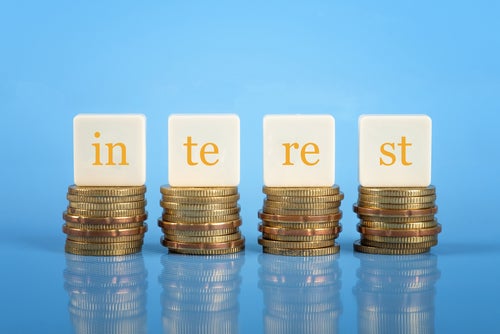
If you understand how interest works, then you understand that the higher the interest rate, the more money you are paying to borrow that money over the life of that loan, no matter what it is for. So naturally you want to get the lowest interest rates possible whenever borrowing money.
Well, there are two tried and true ways to lower your interest rates when it comes to big-ticket item purchases, such as a house or a car — and even for using a credit card.
One is to pay more toward the down-payment, especially true of mortgage loans, but also true in auto loans. And the other fool-proof way is to raise your credit score.
Both require smarter spending and payment strategies and saving your money to achieve the goal of lower interest rates.
Increase your down payment
When it comes to mortgage loans, where even half a percent interest higher makes a huge difference in the amount you pay back after 30 years, most lenders charge higher fees to those whose down payments are less than 20% of the total purchase price for a mortgage loan, in addition to a required mortgage insurance premium. A lender could also structure a deal to charge higher interest rates instead of some fees that are not required or you can pay higher fees to reduce the interest rate. The smaller the down payment, the larger the chance of higher fees, paid at closing and higher interest rates.
Most home buyers use the larger down payment to buy a higher-priced house. But you can also use the down payment to reduce the overall amount of the loan so you can get approved at a lower interest rate. I always advocate for buying the least expensive house you can afford instead of the most expensive house you can afford.
The same principle applies when buying cars. Since the average loan amount of new cars financed earlier this year was $27, 612, according to Experian, your credit history, income and cash available might not qualify you at the big banks or big auto finance companies for that amount of a loan. But with a larger down payment, you can reduce the loan amount for the car you want. If you can choose a lower-priced car or reduce the price of the car you want with a bigger down payment to around $15,000 you might be approved at a credit union for an interest rate below 4% even with a less-than-optimal credit score.
When it comes to credit cards, those with poor credit scores who have some cash can build credit with a secured credit card. These cards require a cash security deposit. This down payment is required to open the secured credit card account, establishes your credit limit and is not used for payments. Many secured credit cards start at higher than average interest rates and annual fees (although some do not so search carefully and compare cards), and after demonstrating responsible payment and credit usage behavior for at least a year, you will be able to qualify for a conventional credit card with a lower interest rate.
Increase your credit score
According to Experian, a “good” VantageScore is between 661 and 780. But that is not the “prime” or “excellent” credit that lenders reserve for borrowers with credit scores between 781 and 850. With a score in the low 500s you may not get any approvals for mortgage loans, auto loans or even a credit card.
But, if your low credit score is as high as 550, there are many government mortgage loan programs available from the U.S. Department of Housing and Urban Development (HUD) Federal Housing Administration (FHA), although these low-credit loans do require at least a 10% down-payment.
Just 30 points higher with a credit score of 580, you can qualify for FHA mortgage loans with just 3.5% down payment. But these loans come with many fees, insurance premiums and higher closing costs to get the same rate someone with a better credit score and more down payment could get. A borrower with a higher credit score in the 700s could get a conventional mortgage loan, a lower interest rate with no points and minimal closing costs.
In the wake of the Great Recession, for those with lower credit scores between 550 and 620, mortgage lenders are most interested in your payment ability for housing costs in the last 12 months, and that’s if you’ve got the verifiable income and the cash down payment. If you don’t have that 12-month positive payment history, you can tighten up your bill-paying for the next year while your credit score climbs and you save more cash for the down payment, both resulting in less interest and fees paid overall for your mortgage loan.
Better credit scores are directly related to lower interest rates on auto loans, according to a 2015 Experian report on auto lending. Those with credit scores between 661 and 850 get interest rates between 2.73% and 3.67% for new car loans. Consumers with credit scores below 660 pay between 6.49% and 13.98% for their new car loans. Those with lower credit scores also take extended loan terms to make payments more affordable, and that amounts to paying that higher interest rate for a longer time period, increasing the total cost of the loan.
And, as credit scores drop, used auto loan interest rates rise to 19.73%.
Most car loans for those with credit scores under 600 are made at what’s called “Buy Here Pay Here” (BHPH) car lots where lending is done on the spot (and often sold later to third-party lenders), at the very highest interest rates up to 24%.
If your low credit score is below 600 and you have no verifiable income, and only a small down payment, your only loan approval may come at a BPHP lot for an over-priced used car and a much higher than average low credit interest rate. The good news is, after making on-time payments for at least one year, you can apply to refinance that auto loan at your local credit union where approvals are granted for those with credit scores below 660 for a vastly lower-priced used car in the $15,000 range.
Credit unions are a great place to rebuild your credit because their mission is to help the community and they will give you that chance if you can demonstrate the on-time payment ability for at least one year or more.
Another alternative is to consider credit repair to help you remove errors or outdated negative information on your credit report to see a boost in your score that could result in paying a lower interest rate.
Excellent credit scores between 781 and 850 are also synonymous with receiving offers for credit cards at the lowest interest rates offered today, which are as low as 7.5%. The lower your credit score, the higher the credit card interest rates, which can top out at 25.9%.
If you can become an authorized user on someone else’s credit card account who has excellent credit, you will also be able to benefit from that credit score boost in your own name once that person’s credit history has been added to your credit report.
Some secured cards will allow you to raise your credit limit without additional deposit, which also results in increasing your credit score. I’d suggest waiting one year while demonstrating responsible credit card use and on-time payments before applying for a conventional lower-interest credit card in your own name.
The truth is, the combination of available cash and a higher credit score will net you the very best loan terms and interest rates, so do everything you can to save cash while improving your credit score, 10 points at a time, if you’re planning a major purchase next year.
Related Articles:
Credit Repair and Home-Buying: How to Lower Interest Rates
Great Credit Shouldn’t Cost a Fortune
Ways to Improve Your Credit Score in 2016
Questions about credit repair?
Chat with an expert: 1-800-255-0263






